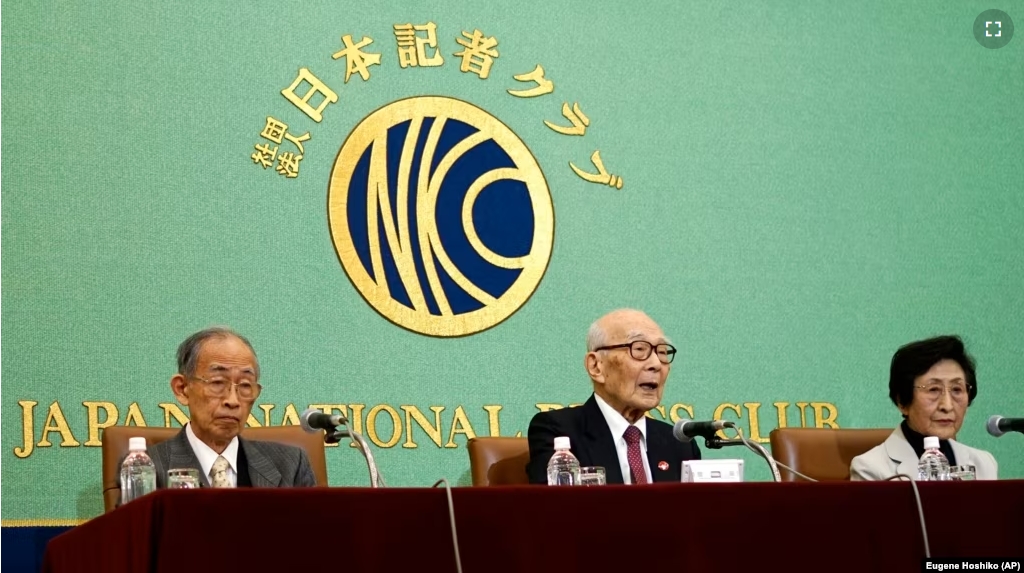Survivors of the U.S. atomic bombings on Hiroshima and Nagasaki said receiving a Nobel Peace Prize has given them new energy to campaign for nuclear disarmament.
Next August will be the 80th anniversary of the two atomic bombings that ended World War II in 1945.
Terumi Tanaka survived the atomic bombing of Nagasaki on August 9, 1945. He said, “I felt like I needed to work even harder on what I had done so far.”
Tanaka is 92 years old. He spoke at a press conference in Tokyo on December 24 after returning from Oslo, Norway. That is where he accepted the Nobel Peace Prize for Nihon Hidankyo, the Japanese atomic bomb survivors’ organization earlier in the month. Tanaka is chair of the organization. He noted that next year is an important point in history marking 80 years since the end of the Second World War.
“I believe it is important to focus on the next 10 years and strengthen the movement moving forward,” he added. “I would like to lead a big movement of testimonials.”
Tanaka is a retired materials engineering professor. He said he wants Japan to take the leadership in nuclear disarmament.
“What else is there for Japan, the only country to have suffered atomic attacks, to do other than leading the nuclear disarmament?”
Nuclear deterrence vs. disarmament
Tanaka said he will ask Prime Minister Shigeru Ishiba about the issue when they are expected to meet in January. Ishiba supports nuclear deterrence, the policy of preventing an attack by having powerful military weapons.
Japan is protected under the U.S. nuclear policy. Japan also has not signed the United Nations’ Treaty on the Prohibition of Nuclear Weapons. All other countries that are believed to have nuclear weapons, including the United States, have also not signed the U.N. treaty.
However, atomic bomb survivors have repeatedly requested the Japanese government to sign the treaty.
Michiko Kodama survived the atomic bombing of Hiroshima, which took place three days before the Nagasaki blast. She said she felt the Nobel Prize and the congratulatory messages were rewards after years of hardship, discrimination and fear of health effects from radiation. But she wants more people to know the real effects of nuclear weapons.
Kodama was seven years old in August 1945. She said that, in 10 years, the survivors of the bombings will no longer be able to “tell the reality of the atomic bombing.” She said, “I want to keep telling our stories as long as we live.”
Nihon Hidankyo has been described as a grassroots movement of Japanese atomic bombing survivors. They have worked for nearly 70 years to continue the taboo around the use of nuclear weapons. However, the weapons have grown in power and number since being used for the first and only time in warfare by the United States on Japan to end the Second World War.
The U.S. atomic bombing of Hiroshima is believed to have killed 140,000 people. The bombing of Nagasaki is estimated to have killed another 70,000 people.
Emperor Hirohito announced Japan’s surrender to the United States on August 15. That brought an end to the conflict between the two countries that began with Japan’s attack on Pearl Harbor in Hawaii, December 7, 1941.
I’m Caty Weaver.
Mari Yamaguchi reported this story for the Associated Press. Jill Robbins adapted it for Learning English.
___________________________________________
Words in This Story
focus – v. to cause one’s attention to be directed at or on something
testimonial – n. a written or spoken statement that praises someone’s work, skill, or character
deterrence – n. the policy of preventing a military attack on your country by having the ability to answer with at least the same or stronger military force
grassroots – adj. a movement or organization that appears to be from normal or average people in society
taboo –n. something that is not permitted by custom or morality
